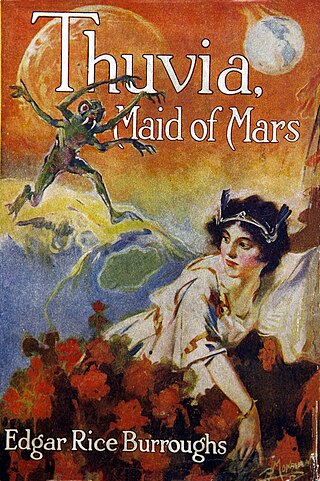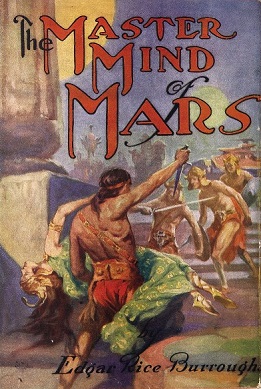
John Carter of Mars is a fictional Virginian soldier who acts as the initial protagonist of the Barsoom stories by Edgar Rice Burroughs. A veteran of the American Civil War, he is transported to the planet Mars, called Barsoom by its inhabitants, where he becomes a warrior battling various mythological beasts, alien armies and malevolent foes. Created in 1911, the character has appeared in novels and short stories, comic books, television shows and films, including the 2012 feature film John Carter, which marked the 100th anniversary of the character's first appearance.

A Princess of Mars is a science fantasy novel by American writer Edgar Rice Burroughs, the first of his Barsoom series. It was first serialized in the pulp magazine All-Story Magazine from February–July, 1912. Full of swordplay and daring feats, the novel is considered a classic example of 20th-century pulp fiction. It is also a seminal instance of the planetary romance, a subgenre of science fantasy that became highly popular in the decades following its publication. Its early chapters also contain elements of the Western. The story is set on Mars, imagined as a dying planet with a harsh desert environment. This vision of Mars was based on the work of the astronomer Percival Lowell, whose ideas were widely popularized in the late 19th and early 20th centuries.

Thuvia, Maid of Mars is a science fantasy novel by American writer Edgar Rice Burroughs, the fourth of the Barsoom series. The principal characters are Carthoris and Thuvia of Ptarth, each of whom appeared in the previous two novels.

The Gods of Mars is a science fantasy novel by American writer Edgar Rice Burroughs and the second of Burroughs' Barsoom series. It features the characters of John Carter and Carter's wife Dejah Thoris. It was first published in The All-Story as a five-part serial in the issues for January–May 1913. It was later published as a complete novel by A. C. McClurg in September, 1918 and in many editions subsequently.

The Warlord of Mars is a science fantasy novel by American writer Edgar Rice Burroughs, the third of his Barsoom series. Burroughs began writing it in June, 1913, going through five working titles; Yellow Men of Barsoom, The Fighting Prince of Mars, Across Savage Mars, The Prince of Helium, and The War Lord of Mars.

The Master Mind of Mars is a science fantasy novel by American writer Edgar Rice Burroughs, the sixth of his Barsoom series. Burroughs' working titles for the novel were A Weird Adventure on Mars and Vad Varo of Barsoom. It was first published in the magazine Amazing Stories Annual vol. 1, on July 15, 1927. The first book edition was published by A. C. McClurg in March, 1928.

Dejah Thoris is a fictional character and princess of the Martian city-state/empire of Helium in Edgar Rice Burroughs' series of Martian novels. She is the daughter of Mors Kajak, Jed (chieftain) of Lesser Helium, and the granddaughter of Tardos Mors, Jeddak of Helium. She is the love interest and later the wife of John Carter, an Earthman mystically transported to Mars, and subsequently the mother of their son Carthoris and daughter Tara. She plays the role of the conventional damsel in distress who must be rescued from various perils, but is also portrayed as a competent and capable adventurer in her own right, fully capable of defending herself and surviving on her own in the wastelands of Mars.

John Carter, Warlord of Mars is a comics series published from 1977 by American company Marvel Comics. Created by Marv Wolfman (writer) and Gil Kane (penciller), it was based on the Barsoom series of Edgar Rice Burroughs and featured the eponymous character.

Lieut. Gullivar Jones: His Vacation is a novel by English writer Edwin Lester Arnold, combining elements of both fantasy and science fiction, first published in 1905. Its lukewarm reception led Arnold to stop writing fiction. It has since become his best-known work, and is considered important in the development of 20th century science fiction in that it is a precursor and likely inspiration to Edgar Rice Burroughs's classic A Princess of Mars (1917), which spawned the planetary romance and sword and planet genres. Ace Books reprinted Arnold's novel in paperback in 1964, retitling it Gulliver [sic] of Mars. A more recent Bison Books edition (2003) was issued as Gullivar of Mars, adapting the Ace title to Arnold's spelling.

Swords of Mars is a science fantasy novel by American writer Edgar Rice Burroughs, the eighth of his Barsoom series. It was first published in the magazine Blue Book as a six-part serial in the issues for November 1934 to April 1935. The first book edition was published by Edgar Rice Burroughs, Inc. in February 1936.
"Allan and the Sundered Veil" is a six-part horror comic story written in the style of a boy's periodical by Alan Moore and illustrated by Kevin O'Neill, included at the back of each issue of The League of Extraordinary Gentlemen, Volume I and collected at the back of that volume. It serves as a prequel to the comic.

Maureen Johnson Smith Long most often referred to as Maureen Johnson, is a fictional character in several science fiction novels by American writer Robert A. Heinlein. She is the mother, lover, and eventual wife of Lazarus Long, the longest-living member of Heinlein's fictional Howard families. She is the only character from the "Lazarus Long cycle" to have an entire fictional memoir devoted to her life.
"Mars: The Home Front" is a short story by American writer George Alec Effinger, published in the 1996 anthology War of the Worlds: Global Dispatches. It is a crossover between H. G. Wells' 1898 novel The War of the Worlds and Edgar Rice Burroughs' Barsoom series.

Synthetic Men of Mars is a science fantasy novel by American writer Edgar Rice Burroughs, the ninth of his Barsoom series. It was first published in the magazine Argosy Weekly in six parts in early 1939. The first complete edition of the novel was published in 1940 by Edgar Rice Burroughs, Inc.

Llana of Gathol is a collection of four science fantasy stories by American writer Edgar Rice Burroughs, which were originally published in Amazing Stories in 1941. The first collected edition of Llana of Gathol was published in 1948 with an apparently new foreword. It is the penultimate book in the Barsoom series and the last to be published during Burroughs's lifetime.

Barsoom is a fictional representation of the planet Mars created by American pulp fiction author Edgar Rice Burroughs. The first Barsoom tale was serialized as Under the Moons of Mars in pulp magazine The All-Story from February to July 1912 and published compiled as a novel as A Princess of Mars in 1917. It features John Carter, a late-19th-century American Confederate veteran who is mysteriously transported from Earth to the dying world of Mars where he meets and romances the beautiful Martian princess Dejah Thoris. Ten sequels followed over the next three decades, further extending his vision of Barsoom and adding other characters.
Thark or Tharks are a fictional tribe of fierce Green Martian warriors on the fictional planet of Barsoom, created by Edgar Rice Burroughs and first featured in the 1917 novel A Princess of Mars.

Ulysses Paxton is a fictional character created by Edgar Rice Burroughs in his novel The Master Mind of Mars. Within the narrative framework of the novel, Captain Paxton, United States Army Infantry, is a fan of Burroughs' Barsoom series, and after having a shell blow off his legs during trench warfare in World War I, he finds himself drawn across the gulfs of space to Mars like John Carter before him. He sends Burroughs a first person manuscript of his adventures on the dying planet, which Burroughs publishes.

Deja or Déja or Dejah is a feminine given name sometimes given in reference to the French word déjà, meaning before. Spelling variants such as Daja and Dajah and elaborations such as Dejanae and Dejanelle, also with multiple spelling variants, are also in use. Déjà vu is a French term referring to the feeling that one has seen events before. In some instances, the name may be derived from a short form of Dejanira. Dejah Thoris is a character in Edgar Rice Burroughs' series of Martian early-20th-century science fiction novels. It is also a surname with various origins in multiple languages.















